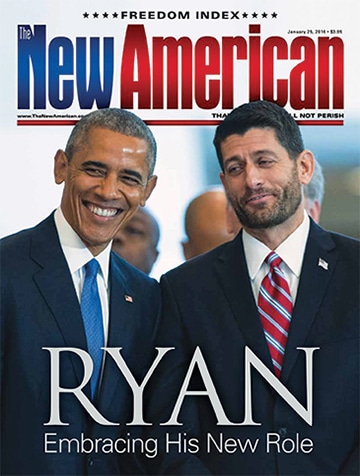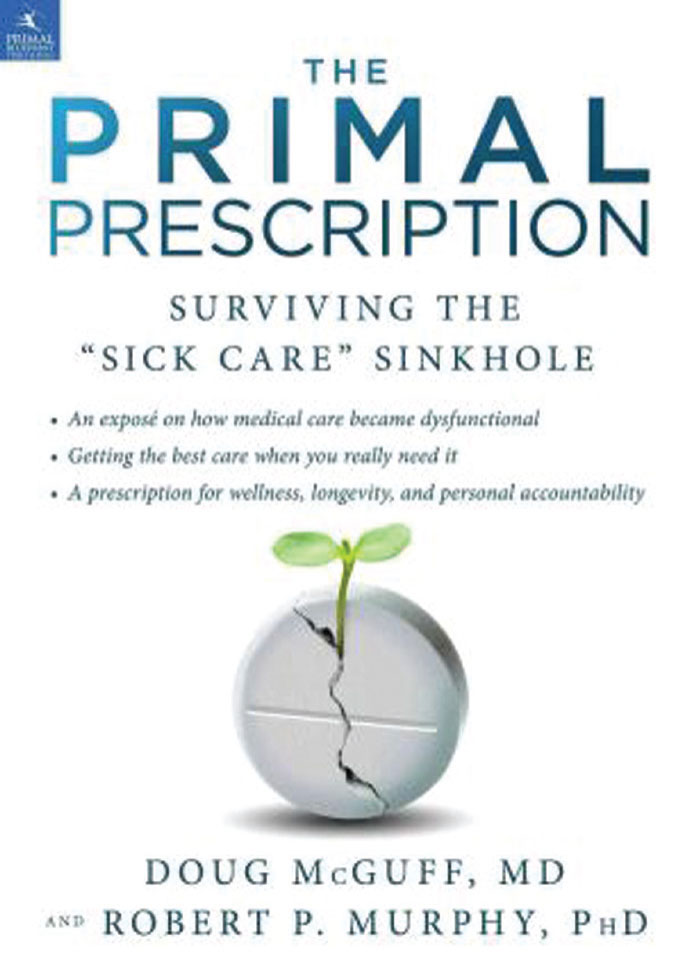Rx for Healthcare
The Primal Prescription: Surviving the “Sick Care” Sinkhole, by Doug McGuff, M.D., and Robert Murphy, Ph.D., Malibu, California: Primal Blueprint Publishing, 2015, 362 pages, hardcover.
The U.S. healthcare system is sick, largely as a result of myriad government interventions. Nevertheless, there are things individuals can do to stay healthy and avoid the worst aspects of the system. Those are the twin messages of The Primal Prescription: Surviving the “Sick Care” Sinkhole.
The book’s authors are Doug McGuff, an emergency physician and personal trainer, and Robert Murphy, a free-market economist. Combining their expertise yields a volume that not only explains how the healthcare system got so screwed up but offers real-world examples of just how bad things really are — and what to do about them.
Anyone who has visited a doctor or hospital in recent years is well aware of the problems plaguing the healthcare system: long waits, countless tests, endless computer-screen tapping, high costs, etc. Most of this is the outcome of decades of government interference.
Such interference often appears to be well-meaning: Who could be opposed to ensuring that drugs are safe or that the elderly have health insurance? Rarely discussed, however, is the fact that many of the problems politicians seek to rectify through new interventions are themselves the result of previous interventions.
Roughly the first half of The Primal Prescription traces the history of these interventions.
For example, government licensing of doctors began in the late 19th century, ostensibly to protect the public from quacks, though it had the side effect of restricting the supply of doctors — which, given that doctors’ groups pushed for such laws, may actually have been their main purpose. As licensing requirements were tightened over the years, a significant doctor shortage arose, which the government then tried to fix by subsidizing medical education, which in turn caused teaching hospitals to become the sole source of healthcare for the indigent (because of “patient-dumping” by other hospitals). In trying to stop that, Congress ended up making emergency rooms “the free clinic and safety net for the American health care system,” write McGuff and Murphy. That, of course, has caused ER overcrowding, cost-shifting, and closings.
Health insurance, too, has long been subject to government tinkering. Although initially intended to cover only catastrophic illness or injury, by the 1930s it began to expand to cover much routine care, helped along by a tax exemption for Blue Cross/Blue Shield. But that tax exemption came at a price: community rating, whereby everyone in a given region must pay roughly the same premium regardless of his health risks. This, the authors observe, created “moral hazard,” in which people are more likely to take risks with their own health because they know they won’t have to foot the bill for their care. “The health insurance model adopted early on by the Blues … set in motion the problems in US health care that would fester over subsequent decades,” aided by the tax exemption of employer-provided insurance.
As costs increased, along came Medicare, which addressed that problem by shifting costs from the elderly and private insurers to taxpayers. Costs continued to rise nonetheless, so price controls were imposed, yet the program is still actuarially insolvent. Furthermore, since the government is paying for seniors’ healthcare, it increasingly decides whether they will live or die.
The Food and Drug Administration (FDA) gets a chapter all to itself as McGuff and Murphy describe the agency’s “double whammy” against Americans: “On the one hand, it prolongs the development of potentially useful drugs, leading to delayed treatment and artificially inflated prices. On the other hand, the FDA also fails to protect Americans from unacceptably dangerous drugs, even when experts in the private sector have raised alarm bells.” (Emphasis in original.)
The interventionist mind-set and its consequences proceeded inexorably to the Affordable Care Act (ACA). As the authors remark, “There is nothing qualitatively different about the ACA; it is simply an extension of trends that have been in motion for decades.” (Emphasis in original.) They demonstrate how the major provisions of the ACA follow logically from the law’s premises. For instance, if the problem of guaranteeing coverage for those with pre-existing conditions is “solved” by forcing insurers to accept all applicants and charge them the same rates as everyone else, it makes perfect sense then to require everyone to buy insurance so as to spread the cost of care for the sick around.
Like all the previous interventions, ObamaCare is doomed to failure. And when its failure becomes clear, rather than reassess the interventionist approach, politicians and voters alike will probably clamor for still more interventions. “The end limit of this process,” assert the authors, “is a ‘single payer’ system, in which the federal government … directly handles medical expenses for all Americans.” That, needless to say, will be even more disastrous than all the antecedent policies.
The good news, according to McGuff and Murphy, is that whether or not these policies are repealed — and repeal certainly seems like a long shot at this time — there are things individuals can do to protect themselves from the healthcare system’s failings.
“If you are concerned about the direction of the country, as you should be, then the single best thing you can do for its future is to make sure your household is healthy,” they write.
Given the book’s title and publisher, it is hardly surprising that the authors recommend the “primal” lifestyle as described in Mark Sisson’s The Primal Blueprint. The idea is to live more as our ancient ancestors — who did not have the rates of heart disease, diabetes, obesity, and other ailments that we do — supposedly lived: Eat mostly vegetables and quality meats; avoid unhealthful foods; participate in a variety of types of exercise; and get adequate sleep, sunlight, and recreation. Doing so, the authors maintain, “will help safeguard you against preventable illness and modern disease, reducing your chance of needing medical care in the first place.”
No matter how healthful one’s lifestyle, he will almost certainly need medical care at some point in his life. Most of the rest of the book, written from McGuff’s perspective, is a primer on “how to get everything good from the health care system as it currently exists, while avoiding as much of the bad as possible.”
The “most crucial step,” says McGuff, is selecting the right physician, one who will act as a “sherpa” to guide you through the system. He recommends finding a doctor who admits his own patients to the hospital and accepts direct cash payment, which will make him your servant rather than your insurer’s. Combine that, if possible, with insurance for catastrophic illness.
Getting off as many medications as possible is also a high priority. “Whenever a disease state exists, the emphasis should be on addressing and correcting an underlying cause, not on immediately prescribing a drug to treat the symptoms or to ‘manage’ the disease,” McGuff declares. He warns that there will be both psychological and physical effects of weaning your body from drugs, but they are manageable and worth it to be free of dependence on chemicals.
Hospitals are probably the part of the healthcare system that places patients at the greatest risk, not because the doctors and nurses don’t care about the patients but because so many factors seem to conspire against quality care. McGuff recommends a litany of steps to take to protect yourself while in the hospital, including having a personal physician; getting a family member or close friend to serve as your advocate; and walking around, coughing, and breathing deeply from time to time.
Medical screening tests such as colonoscopies, which have exploded in number in recent decades, are also discussed in detail. Most have value for patients with elevated risk for the condition for which they are testing; but for other patients, the risks often far outweigh the benefits. The tests themselves involve some level of risk, but the risk of false positives — only nine percent of women whose mammograms show a positive result actually have breast cancer — is often the bigger problem. Some patients who test positive end up undergoing treatment for a disease they don’t have, while others eventually learn that they are disease-free but suffer psychological damage for years afterward.
In addition, McGuff provides a lengthy overview of how to determine if you should undergo an elective procedure and, if so, how to obtain the best one you can.
The Primal Prescription is written in a conversational style, avoiding jargon, and brims with anecdotes illustrating the authors’ contentions. It would probably be worth the price for either the history of government interventions into the healthcare system or the guidance on improving one’s health (even if one doesn’t subscribe to the primal lifestyle) and navigating the system; the pairing makes it even more valuable. It is precisely what one would expect from a doctor: diagnosing the problem — in this case, with an economist on board for a second opinion — and discussing treatment options. For the ailing American healthcare system, the cure, the two men conclude, is “freedom and independence.”


